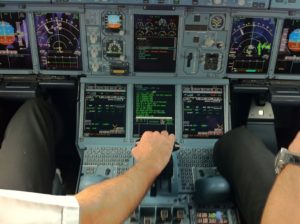Aerospace
FAA mandatory Rules for Instagram Pilots Footage

FAA mandatory Rules for Instagram Pilots Footage – In this new era where the world is so small, you can connect to anyone around the world by flying a luxurious Gulfstream G650 or travelling by an low cost airline, posting pictures and selfies about travelling or your work or your hobby or an incident occurred in aircraft is common. For passenger flying and posting it in social media gets likes and appreciation but is it OK for the same by a pilot?
As per the Department of Transportation, Federal Aviation Administration (FAA) using of Personal Electronic Devices (PED) on the flight deck is prohibited under part 121 of FAA. This rule states flight-crew members are prohibited from using a personal wireless communications devices or laptop computer for personal use while at their duty station on the flight deck while the aircraft is being operated. It is intended to ensure that certain non-essential activities to not get more attention than situational activities, or to not make more challenging to other crew members work and management in the flight deck. But pilots of Instagram and Facebook has shown how poorly the rules are being followed. Usage of electronic devices in cockpit to entertain take-offs and landing videos and pictures, are these allowed? or its prohibits? It leaves us a question.
Read more : 12 things to know about Airbus A320 family
When are pilots allowed take pictures?
In the United States, different regulations apply to different kinds of flights. Lets take an example, If you are a commercial flight pilot with passengers and using digital camera or film with no ability to transfer the data wirelessly, and you are not in a critical phase like taxi, take-off or landing, and your camera has been approved for mounting and recording by FAA, You are Good to Go! Captain.
If you are in jump-suit just ask permission of the captain.
Smartphones and tablet are prohibited whether it is personal or issued by airlines, FAA states what makes a device “personal” is how it’s being used, not its owner.
A personal wireless device may only be used if it is directly related to operation of the aircraft, or for emergency, safety-related, or employment-related communications, according to air carrier procedure.
Read more : What Happens When Lightning Strikes an Airplane?
According to the source from Quora by Tom Chai– This is taken by the crew of Qantas 32 when their engine exploded, creating multiple system degradation and failures, with ECAM messages flooding the screen for them to troubleshoot, they handled the situation correctly and expertly, saving everyone on board and minimized asset losses, yet they still managed to take pictures, because this really is an once-in-a-hundred-lifetimes event.


Aerospace
Boeing Transfers Rocket Stage to NASA, Paving Way for Human Moon Mission

Boeing has achieved a significant milestone by providing NASA with the second core stage of the Space Launch System (SLS) rocket.
This crucial component, crafted at NASA’s Michoud Assembly Facility (MAF), is set to propel the Artemis II crew into lunar orbit, marking humanity’s return to deep space after a 50-year hiatus.
The monumental Boeing-built rocket stage, the largest element of the Artemis II mission, will embark on a journey aboard the Pegasus barge, traveling 900 miles to NASA’s Kennedy Space Center.
Comparison of two legendary aircraft B777x vs B747 aircraft:Click here
Upon arrival, it will be meticulously integrated with other essential Artemis II components, including the upper stage, solid rocket boosters, and NASA’s Orion spacecraft within the iconic Vehicle Assembly Building. This intricate integration process is a vital step toward the eagerly anticipated Artemis II launch, slated for 2025.
“Boeing-built products helped land humankind on the moon in 1969, and we’re proud to continue that legacy through the Artemis generation,” remarked Dave Dutcher, vice president and program manager for Boeing’s SLS program. “Together, with NASA and our industry partners and suppliers, we are building the world’s most capable rocket and paving the way to deep space through America’s rocket factory in New Orleans.”
NASA, Lockheed Martin Reveal X-59 Quiet Supersonic Aircraft:Click here
The delivery of Core Stage 2 marks a significant achievement in the evolution of the SLS rocket. Towering over 200 feet and powered by four RS-25 engines, this core stage, coupled with two solid-fueled booster rockets, will generate a staggering 8.8 million pounds of thrust. This immense power is crucial to launching Artemis II and future missions into the vast expanse of space.
The SLS rocket stands unparalleled in its capability to transport both crew and substantial cargo to the moon and beyond in a single launch. Its extraordinary capacity will facilitate the delivery of human-rated spacecraft, habitats, and scientific missions to destinations including the moon and Mars, ushering in a new era of space exploration.
-

 Travel1 week ago
Travel1 week agoAir India to Expand US Operations with Three New Routes After a Decade
-

 Travel2 weeks ago
Travel2 weeks agoWhy We Should Avoid These Stamps in a Passport
-

 Airlines1 month ago
Airlines1 month agoInvestigations Reveal Fake Chinese Titanium in Boeing and Airbus Jets
-

 Tech4 weeks ago
Tech4 weeks agoChina’s CATL Plans 1,800-Mile Electric Plane Launch by 2027
-

 Airport3 days ago
Airport3 days agoTop 10 Largest Airports in the World by Size
-

 Aerospace4 weeks ago
Aerospace4 weeks agoChina’s Fighter Jets Turn Wings into Autonomous Drones
-

 Airlines4 days ago
Airlines4 days agoAir India Rolls Out A350s for Delhi-New York JFK and Newark Routes
-

 Defence3 weeks ago
Defence3 weeks agoBoeing Enhances Chinook with New Engines and Block II Upgrades at $96 Million







